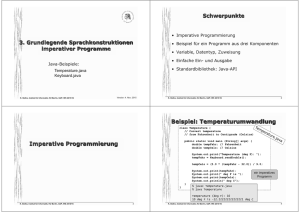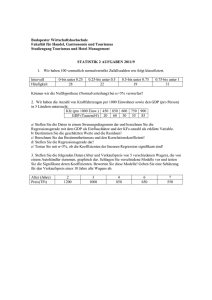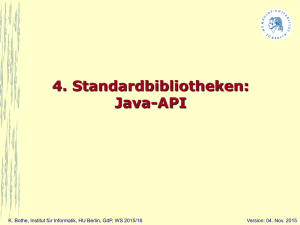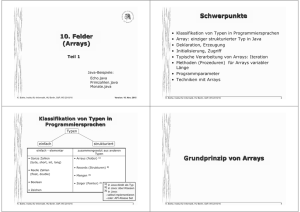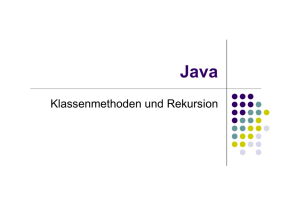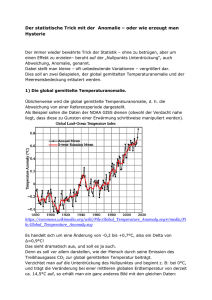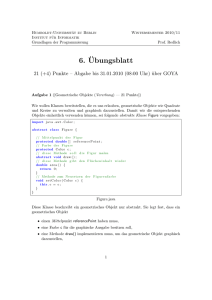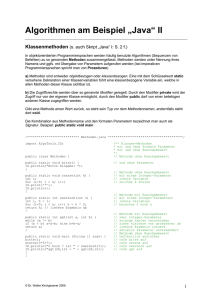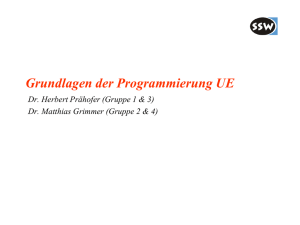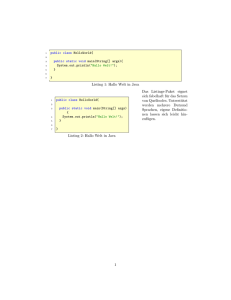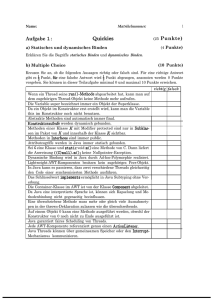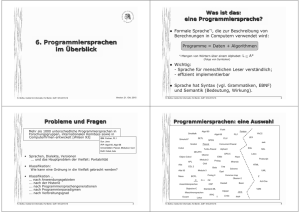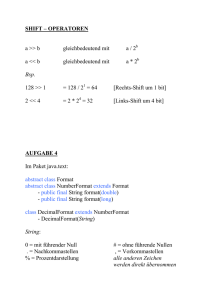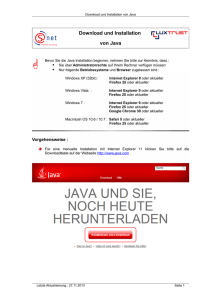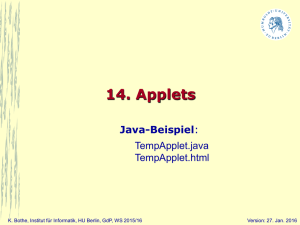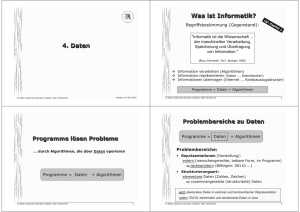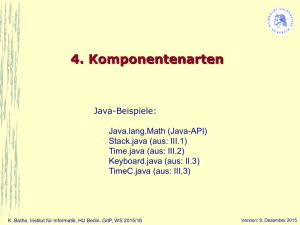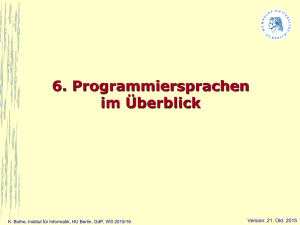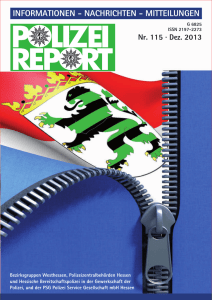System.out.print(tempFahr)
Werbung
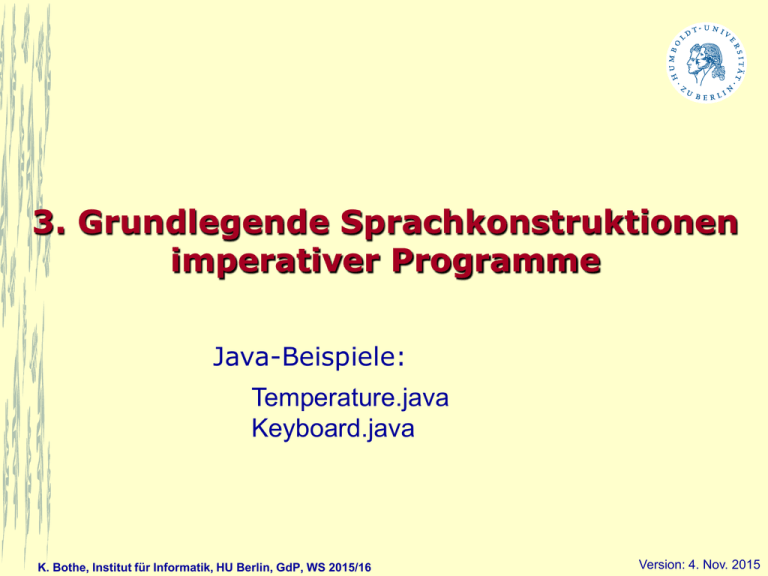
3. Grundlegende Sprachkonstruktionen
imperativer Programme
Java-Beispiele:
Temperature.java
Keyboard.java
K. Bothe, Institut für Informatik, HU Berlin, GdP, WS 2015/16
Version: 4. Nov. 2015
Schwerpunkte
• Imperative Programmierung
• Beispiel für ein Programm aus drei Komponenten
• Variable, Datentyp, Zuweisung
• Einfache Ein- und Ausgabe
• Standardbibliothek: Java-API
K. Bothe, Institut für Informatik, HU Berlin, GdP, WS 2015/16
2
Imperative Programmierung
K. Bothe, Institut für Informatik, HU Berlin, GdP, WS 2015/16
3
Beispiel: Temperaturumwandlung
class Temperature {
// Convert temperature
// from Fahrenheit to Centigrade (Celsius)
public static void main (String[] args) {
double tempFahr; // Fahrenheit
double tempCels; // Celsius
System.out.print("Temperature (deg F): ");
tempFahr = Keyboard.readDouble();
tempCels = (5.0 * (tempFahr - 32.0)) / 9.0;
System.out.print(tempFahr);
System.out.print(" deg F is ");
System.out.print(tempCels);
System.out.println(" deg C");
}
}
ein imperatives
Programm
% javac Temperature.java
% java Temperature
Temperature (deg F): 10
10 deg F is -12.222222222222221 deg C
K. Bothe, Institut für Informatik, HU Berlin, GdP, WS 2015/16
4
Temperatur-Beispiel: als Pascal-Programm
(Standard-Pascal)
PROGRAM Temperature;
{Convert temperature
from Fahrenheit to Centigrade (Celsius)}
VAR tempFahr: real;
tempCels: real;
BEGIN
writeln("Temperature (deg F): ");
readln(tempFahr);
tempCels := (5.0 * (tempFahr - 32.0)) / 9.0;
write(tempFahr);
write(" deg F is ");
write(tempCels);
writeln(" deg C");
END.
K. Bothe, Institut für Informatik, HU Berlin, GdP, WS 2015/16
5
Imperative Programmierung:
Grundansatz
Imperative Programmierung orientiert auf die
Beschreibung von Algorithmen.
• Algorithmus:
Verfahren zur Berechnung gesuchter Werte aus
gegebenen Werten, . . . das auf der schrittweisen
Ausführung von elementaren Verarbeitungsoperationen
beruht.
• Imperatives Programm:
Algorithmen durch Bearbeitung der Variablenwerte
beschrieben
(Verändern und Lesen der Werte)
tempCels = (5.0 * (tempFahr - 32.0)) / 9.0;
K. Bothe, Institut für Informatik, HU Berlin, GdP, WS 2015/16
6
Imperatives Pascal-Programm
PROGRAM Temperature ;
VAR tempFahr : real ;
tempCels : real ;
BEGIN
Eingabewerte
in Eingangsvariablen
...
readln (tempFahr);
Algorithmus
tempCels := (5.0 * tempFahr ...);
write (tempCels);
END.
K. Bothe, Institut für Informatik, HU Berlin, GdP, WS 2015/16
Ausgabewerte
in Ausgangsvariablen
7
Imperatives Java–Programm
class Temperature
{
public static void main (...)
{
double tempCels;
Eingabewerte
double tempFahr;
...
in Eingangsvariablen
tempFahr = Keyboard.readDouble();
Algorithmus
tempCels = (5.0 * tempFahr ...);
System.out.print(tempCels);
}
}
Ausgabewerte
in Ausgangsvariablen
K. Bothe, Institut für Informatik, HU Berlin, GdP, WS 2015/16
8
Imperative Programmierung:
Eigenschaften im Detail
• Basiskonzepte: Variable, Anweisung
• Variable:
besitzt Wert, der durch Anweisungen gelesen
und verändert wird
• Anweisung:
dient dem Zugriff auf Variablen-Werte
(Lesen und Verändern von Werten)
• Grundlegende Strukturierungsmethode imperativer
Programme:
Prozedur (Funktion, Methode)
• Prozedur (Funktion, Methode):
Teilalgorithmus: mit Anweisungen der Sprache
K. Bothe, Institut für Informatik, HU Berlin, GdP, WS 2015/16
9
Mehrkomponenten-Programm
K. Bothe, Institut für Informatik, HU Berlin, GdP, WS 2015/16
10
Aus wie vielen Komponenten besteht das
Java-Programm?
class Temperature {
// Convert temperature
// from Fahrenheit to Centigrade (Celsius)
public static void main (String[] args) {
double tempFahr; // Fahrenheit
double tempCels; // Celsius
System.out.print("Temperature (deg F): ");
tempFahr = Keyboard.readDouble();
tempCels = (5.0 * (tempFahr - 32.0)) / 9.0;
System.out.print(tempFahr);
System.out.print(" deg F is ");
System.out.print(tempCels);
System.out.println(" deg C");
}
}
K. Bothe, Institut für Informatik, HU Berlin, GdP, WS 2015/16
11
Temperatur-Programm:
besteht aus d r e i Komponenten
File: Temperature.java
class Temperature
...
}
File: Keyboard.java
{
class Keyboard
{
...
}
Eingabe
nutzerdefinierte Klassen
class System
{
...
}
Ausgabe
Java API
(application programming interface)
= Standardbibliothek
getrennte Compilation
K. Bothe, Institut für Informatik, HU Berlin, GdP, WS 2015/16
12
Klasse 'Keyboard'
import java.io.*;
class Keyboard {
//
//
//
//
Author: M. Dennis Mickunas,
June 9, 1997 Primitive Keyboard
input of integers, reals,
strings, and characters.
static
static
static
static
static
boolean iseof = false;
char c;
int i;
Aufgabe der
double d;
Klasse?
String s;
/* WARNING: THE BUFFER VALUE IS SET
TO 1 HERE TO OVERCOME ** A KNOWN BUG
IN WIN95 (WITH JDK 1.1.3 ONWARDS)*/
static BufferedReader input
= new BufferedReader (
new
InputStreamReader(System.in),1);
public static int readInt () {
if (iseof) return 0;
System.out.flush();
try {
s = input.readLine();
}
catch (IOException e) {
System.exit(-1);
}
if (s==null) {
iseof=true;
return 0;
}
i = new
Integer(s.trim()).intValue();
return i;
}
public static char readChar () {
if (iseof) return (char)0;
System.out.flush();
...
Mangel: keine übersichtliche
Darstellung für die Nutzer der Klasse
K. Bothe, Institut für Informatik, HU Berlin, GdP, WS 2015/16
13
Klasse Keyboard: eine Abstraktion
class Keyboard {
Nur das ist für die
Anwendung wichtig
public static int readInt () ;
public static char readChar () ;
public static double readDouble () ;
public static String readString () ;
public static boolean eof () ;
}
Sammlung nützlicher Funktionen zur
Eingabe von ganzen Zahlen, Zeichen,
reellen Zahlen, Zeichenketten von der
Tastatur
K. Bothe, Institut für Informatik, HU Berlin, GdP, WS 2015/16
14
Temperatur-Programm:
Interface zwischen Komponenten
File: Temperature.java
class Temperature {
public static void main (String [] args) {
...
tempFahr = Keyboard.readDouble();
System.out.print(" deg F is ");
...
}
}
Java API (=Standardbibliothek)
class System {
...
public....out;
}
nutzerdefinierte Klassen
class Keyboard {
...
public readDouble (...)
...
}
K. Bothe, Institut für Informatik, HU Berlin, GdP, WS 2015/16
File:
Keyboard.java
15
Grundelemente
von Java-Programmen
K. Bothe, Institut für Informatik, HU Berlin, GdP, WS 2015/16
16
Grundstruktur von Java-Programmen
K l a s s e = grundlegende Komponente
Klassenname
Klassenkörper (Beginn)
class Temperature {
public static void main (String [] args)
{
double tempFahr;
Methodendeklaration
...
}
Variablendeklaration
}
Klasse: ’Sammlung’ von
- Variablendeklarationen
- Methodendeklarationen
(Methode = Algorithmus, Prozedur, Funktion)
je Gesamtprogramm: e i n e Methode m a i n ( )
dort beginnt die Abarbeitung !
(wie Hauptprogramm in Pascal)
K. Bothe, Institut für Informatik, HU Berlin, GdP, WS 2015/16
17
Variablendeklaration
double tempFahr;
Typ
Variable
Wirkung:
1. Wertebereich der Variablen festlegen
2. Speicherplatzgröße entsprechend Typ festgelegt
z. B. double: 8 Byte
3. erlaubte Operationen
einfache Typen:
Java-EBNF: 'Standardtyp'
boolean, char, byte, short, int, long, float, double
K. Bothe, Institut für Informatik, HU Berlin, GdP, WS 2015/16
18
Kommentare
class Temperature {
// Convert temperature
// from ...
double tempFahr; // Fahrenheit
// bis Zeilenende
/* dazwischen */
int /* nur hier */ temp;
K. Bothe, Institut für Informatik, HU Berlin, GdP, WS 2015/16
19
Einfache Anweisungen:
Zuweisung und Aufruf einer Methode
aus Klasse Keyboard: Methode readDouble
tempFahr = Keyboard.readDouble();
Zuweisung
tempCels = (5.0 * (tempFahr - 32.0)) / 9.0;
System.out.print(tempFahr);
Aufruf einer Methode
( Eingabe / Ausgabe )
K. Bothe, Institut für Informatik, HU Berlin, GdP, WS 2015/16
20
